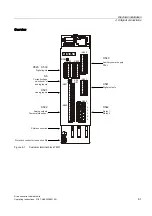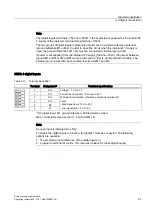
Electrical installation
4.4 Introduction to EMC
Drive converter cabinet units
48
Operating Instructions, 07/07, A5E00288214A
4.4
Introduction to EMC
What is meant by EMC?
Electromagnetic compatibility (EMC) describes the capability of an electrical device to
function satisfactorily in an electromagnetic environment without itself causing interference
unacceptable for other devices in the environment.
EMC therefore represents a quality feature for the
●
Internal noise immunity: Resistance to internal electrical disturbances
●
External noise immunity: resistance against external electromagnetic disturbances
●
Noise emission level: environmental effects caused by electromagnetic emissions
To ensure that the cabinet unit functions satisfactorily in the system, the environment subject
to interference must not be neglected. For this reason, special requirements exist regarding
the structure and the EMC of the system.
Operational reliability and noise immunity
In order to achieve the greatest possible operational reliability and immunity to noise of a
complete system (converter, automation, drive machines etc.), measures must be taken by
the converter manufacturer and the user. Only when all of these measures have been taken
are the satisfactory function of the converter and compliance with the legal requirements
(89/336/EEC) ensured.
Noise emissions
Product standard EN 61800 – 3 outlines the EMC requirements for variable-speed drive
systems. It specifies requirements for converters with operating voltages of less than 1000 V.
Different environments and categories are defined depending on where the drive system is
installed.
0HGLXPYROWDJHQHWZRUN
'LVWULEXWLRQ
RIFRQGXFWHG
IDXOWV
,QGXVWULDO
ORZYROWDJHQHWZRUN
3XEOLF
ORZYROWDJHQHWZRUN
0HDVXULQJSRLQWIRU
FRQGXFWHG
IDXOWV
)LUVW
HQYLURQPHQW
6HFRQG
HQYLURQPHQW
(TXLSPHQW
DIIHFWHGE\
IDXOWV
'ULYH
LQWHUIHUHQFH
VRXUFH
/LPLWRIIDFLOLW\
0HDVXULQJSRLQWIRUHPLWWHG
LQWHUIHUHQFH
P
Figure 4-1
Definition of environments 1 and 2
















































